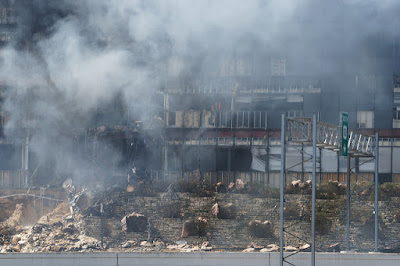Pic Credits: flickr
1. Make sure the fire is out and your home is safe
We all know that if smoke is left too long to set into your home it will make it more difficult to clean and get rid of. This may tempt you to get started on the smoke damage cleanup soon after a fire. However, before jumping at the task it is important to make sure the fire is completely out from the actual source and other potential areas.
2. Wear protective gear
Always wear protective equipment before starting any cleaning process that involves contact with chemicals or other contaminants. This is even more important when dealing with leftover soot as the particles could cause irritation to your eyes, skin and even breathing problems. To shield yourself against toxic substances and avoid health hazards make sure you wear protective clothing, a pair of gloves, goggles, and a face mask. Remember safety comes first.
3. Avoid any delay
As said earlier, the longer the soot and smoke is left to set, the more difficult it is to clean up and repair the damaged areas. Soot stains can even become permanent if smoke damage is left untreated for a very long period. Not forgetting the strong unpleasant odours emitted by soot can cause respiratory issues, and for those suffering from asthma might experience a bad attack. The sooner the soot and smoke damage cleanup is done, lesser the risk of any health problems and further damage.
4. Ensure proper ventilation
Once the situation is stable, switch off the HVAC system to prevent smoke and soot particles from spreading to other areas. This should be done as soon as possible to avoid damage from spreading throughout your home.
Once the HVAC is turned off, open up doors and windows to let soot particles out and ensure proper ventilation. Remember to change the air filters on your HVAC system once the smoke damage cleanup is complete.
5. Dispose of smoke-damaged food
Any food that is exposed to smoke may store soot particles which are hazardous to health. Hence it is important to throw away any such contaminated food to prevent health complications. If the food was left open, without any second thoughts it should be discarded. Don't forget to check the contents in your refrigerator and cupboard as well. If the seal of the refrigerator has been compromised there's a possibility of smoke getting in and affecting the contents.
Even canned food can be at risk of contamination if exposed to extreme heat as the bacteria present get activated and start growing. Thus, it’s always good to discard canned food after a fire instead of salvaging them.
If you are unsure if a food item is safe to consume, throw it out. Your health is worth more than a slice of meat or a can of baked beans.
6. Check your fabrics
While doing the smoke cleanup, check for any signs of damage on any fabric/clothing exposed to fire. Any fabric that has suffered burn holes should be discarded right away. Clothes that are not really burnt but only covered in soot may still be salvageable.
7. Inspect your electronics
Electronics (TVs, DVD players, computers, etc) are delicate items, and smoke can do substantial damage to them if left in the open. After a fire, do a thorough check on all electronic items in the smoke damaged area for signs of soot or charring. If possible try and remove the soot from these devices/appliances to prevent them from getting permanently damaged. You may also document the fire damage to file an insurance claim.
8. Use a handheld vacuum
If you decide to vacuum the smoke and soot damaged carpetings and walls, avoid using the vacuum's brush attachment. As the bristles could rub the soot deeper into the damaged surface, making the smoke damage cleaning and removal process all the more difficult.
As an alternative, you could use a handheld vacuum or a vacuum's hose attachment, holding the nozzle two inches above the affected surface. This will help to suck up soot particles effortlessly and avoid rubbing them deeper into the surface. Although a vacuum is useful, it does not remove soot particles completely. Hence, further smoke cleanup is important.
9. Prepare cleaning solutions
It is important to mix cleaning agents with water in right proportions for cleaning surfaces. Using too much chemical can worsen the damage, and too little will not be effective at all.
10. Ask for help
Cleaning up a smoke damaged area can be a tedious task. For a speedy restoration, you can always ask family members, friends, neighbours for help or call a professional cleaning company to handle the cleaning process.
If your home has suffered major fire damage, leaving it covered in soot and filled with unpleasant smoke, call Classique ChemDry on 1800 213 006. We will clean, repair and restore your home!


This comment has been removed by the author.
ReplyDelete